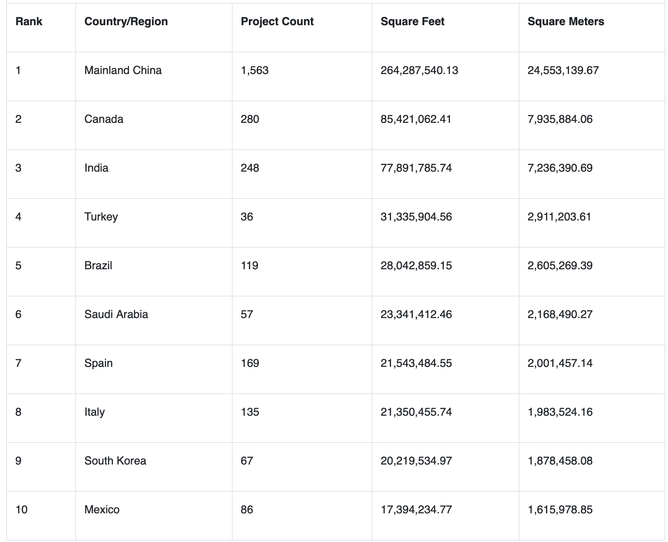USGBC: China Leading Global Charge in Sustainable Buildings

The green building movement is now truly global.
That’s the conclusion of the US Green Building Council (USGBC), which recently released its annual ranking of countries and regions outside of the US that are making significant strides in sustainable design, construction and operations.
Armed with a vision of a sustainable built environment within the next generation, non-profit organisation USGBC provides LEED (Leadership in Energy and Environmental Design) – the world’s most widely used green building rating system.
More than 100,000 commercial buildings have so far achieved LEED Certification, with projects from over 180 different countries seeking certification for their environmentally conscious practices.
In 2023 alone, there were more than 6,000 LEED commercial projects worldwide – reflecting the rise in international demand for buildings that help reduce emissions and support health and wellbeing.
Unsurprisingly perhaps, given the size of their populations, the world’s two most populous nations China and India ranked in the top three for LEED-certified buildings globally and outside of the US.
While the US remains the world’s largest market for LEED, China led the global charge with 1,583 LEED projects certified across both buildings and spaces in 2023, encompassing more than 264 million sq-ft.
Canada followed China with 280 projects equalling 86 million sq-ft, while India retained its third-place status with 248 projects covering 77 million sq-ft.
Turkey broke into the top five, ranking fourth with 36 projects and Brazil rounded out the top five with 119. While Saudi Arabia, at number 6 with 57 projects, took its place in the top 10 for the first time replacing the UAE, which ranked sixth last year.

China Continues Leadership in LEED-Certified Green Buildings
This marks the third consecutive year that China has topped the international list, previously reaching 1,121 certified projects in 2022.
China’s lead in eco-friendly building follows the country’s rapid development in urbanisation, especially across large cities such as Beijing, Shanghai, and Guangzhou and Shenzhen in Guangdong province – where existing buildings are being greened as enterprises increasingly look to reach net-zero emissions.
Like much of the world, China is pursuing a decarbonisation strategy using subsidies and governmental policy – which includes tighter requirements in key sectors including infrastructure, transportation, and industrial parks – with a goal to be carbon neutral country-wide by 2060.
“China continues to be a global leader for LEED green building due in large part to the commitment of companies and organisations to transform our communities into healthier, more sustainable places for us all,” said Andy To, managing director, GBCI China and Northeast Asia.
The projects certified in 2023 represent a broad range of sectors that are using LEED as a critical tool to support ESG strategies and meet climate goals, explains To.
There are four levels of LEED certification, from Certified to Silver, Gold and the top, Platinum.
Among LEED certification projects in China, the headquarters of WeBank and Volkswagen Group China (both Platinum pre-certification), headquarters of JLL Shanghai (world’s first WELL and LEED-Platinum), and Nike China’s Logistics Center, the country’s first LEED Platinum warehouse. Not to mention, Johnson Controls Asia-Pacific HQ in Shanghai with LEED Platinum.
Other global organisations taking ambitious climate action across operations globally, including in China, Unilever and McDonald’s are leading the charge.
As the fast-food giant’s fastest-growing enterprise, McDonald’s China has been rolling out on average one LEED-certified green restaurant each day since its first in 2018 – opening 1,800 LEED-certified restaurants by the end of 2022 and being named company with world’s most LEED projects.
Meanwhile, the world’s largest consumer goods company Unilever now has 10 LEED-certified manufacturing, distribution and logistics facilities across China with more on the way.
With the aim to achieve net-zero operational carbon across its operations by 2030, Unilever is accelerating its green building goals to hit this target – recently pursuing LEED Zero for its Hefei Logistics Center in Hefei, Anhi.
After landing Platinum certification under LEED for Building Design and Construction in 2017, Unilever Hefei became the first logistics project in east Asia to obtain LEED Zero Carbon and LEED Zero Energy dual certification in 2022.
As well as scoring top international with LEED commercial projects, China landed a large number of certifications from other programmes, including 10 TRUE Zero Waste projects representing 1.29 million certified sqs and five LEED for Cities and Communities projects.






